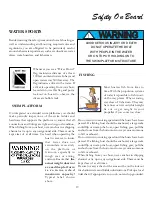
5
Safety On Board
TYPE II PDF
BUOYANT VEST
Refer to the USCG minimum equipment requirements at
the end of this chapter. It is meant to be a guide only.
Contact state and local agencies for additional equipment
requirements. Remember as the captain of your vessel
you are responsible for its safe operation.
TYPE II-
Also known as near-
shore buoyant vest, it is
recommended for calm, inland
water where rescue time will be
minimal. It will turn some
unconscious people face-up in the
water but not as numerous as Type
I. They are available in adult,
medium child, along with infant
and small child sizes.
TYPE III-
Known as a flotation
aid it is good for calm, inland
water or where there is a chance
for quick rescue. It is designed so
wearers can place themselves in
a face-up position in the water.
The wearer may have to tilt their
head back to avoid turning face-
down in the water.
TYPE I-
Also known as an off-
shore jacket, it provides the most
buoyancy. It is a PFD for all waters
and is especially useful in rough
waters where rescue may
encompass additional time. It is
designed to turn most unconscious
users in the water to a face-up
position. Type I PFD is available
in adult & child sizes.
TYPE I PFD
TYPE IV-
Intended for calm,
inland water with heavy vessel
traffic, where help is constantly
present. It is designed to be thrown
into the water for someone to grab
on to and held until rescued. It
should
not
be worn. Type IV
includes ring buoys, buoyant
cushions, and horseshoe buoys.
TYPE IV PDF
TYPE V HYBRID
TYPE V-
This is the least bulky
of all PFD’s. It contains a small
amount of inherent buoyancy,
and an inflatable chamber. It is
rated even to a Type I, II, or III
PFD (as noted on the jacket
label) when inflated. Hybrid
PFD’s must be worn to be
acceptab
le.
TYPE III
Summary of Contents for 30 EXPRESS
Page 1: ...30 EXPRESS OWNER S MANUAL...
Page 2: ...784022 OWNER S MANUAL 30 EXPRESS 12 2012...
Page 30: ...11 Safety On Board NAVIGATION LIGHT RULES...
Page 41: ...Chapter 2 22 Notes...
Page 44: ...3 Rules Of The Road NAVIGATION RULES...
Page 85: ...28 Chapter 5 Notes...
Page 105: ...4 Chapter 7...
Page 106: ...5 Equipment Operation...
Page 107: ...6 Chapter 7...
Page 108: ...7 Equipment Operation...
Page 109: ...8 Chapter 7...
Page 110: ...9 Equipment Operation...
Page 111: ...10 Chapter 7...
Page 117: ...16 Chapter 7...
Page 126: ...25 Equipment Operation ROTARY ENCODER AND MENU KEY...
Page 127: ...26 Chapter 7 USING THE ROTARY ENCODER AND MENU KEY...
Page 158: ...57 Equipment Operation BACKING A TRAILER 1 2 3 4 LAUNCHING RAMP...
Page 161: ...60 Chapter 7 Notes...
Page 195: ...34 Chapter 8 Notes...
Page 204: ...9 Troubleshooting TOILET SYSTEM DIAGNOSTIC CHART...
Page 209: ...14 Chapter 9...
Page 219: ...6 Chapter 11 Notes...
Page 221: ...2 Chapter 12...
Page 224: ...5 Technical Information 30 Express Deck Overview 30 Express Cabin Overview...
Page 225: ...Technical Information 12 6 30 EXPRESS...
Page 226: ...12 7 Technical Information 30 EXPRESS...
Page 227: ...Technical Information 12 8 30 EXPRESS...
Page 228: ...12 9 Technical Information 30 EXPRESS...
Page 229: ...Technical Information 12 10 30 EXPRESS 30 EXPRESS...
Page 230: ...12 11 Technical Information TYPICAL NEGATIVE GROUND SYSTEM...
Page 231: ...Technical Information 12 12 30 EXPRESS...
Page 232: ...12 13 Technical Information 30 EXPRESS...
















































